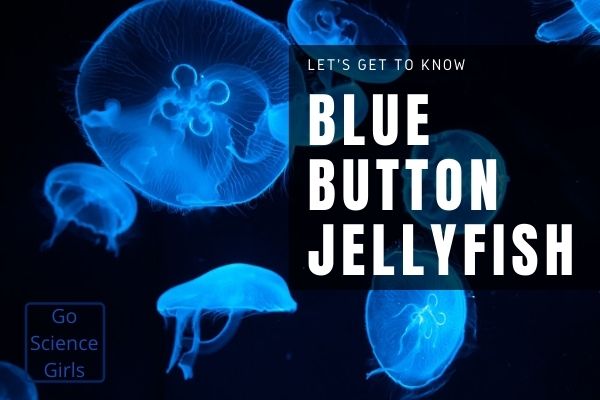Have you ever heard of “Blue Button Jellyfish”?
“Porpita porpita”, is the scientific name (universal name) of this Blue Button, and is recognized as a pulsating “blue-Jelly”.
However, it’s not a jellyfish or sea jelly; but, a kind of Hydroid, which is an animal of the Hydrozoa class.
They are also known as colonial-animals and sometimes introduced to just as “blue-buttons.”

Mates, today we’re going to see an unusual kind of footage about small water-animals related to biology; In which we will see a Blue Button Jelly with some Blue Glaucus and find here how these two nature’s animals float on the water!
Moreover, we’ll also mark this, how some of those Blue Glaucus try to prey and consume a larger size Blue Button Jelly than their body!
This captivating video was broadcasted by the Enoshima Aquarium YouTube channel.
They were able to obtain a group of Blue Button Jellyfishes and Blue Glaucus, so they tried to observe the predation that we rarely see.
Watch, The Blue Button Jelly (Porpita Porpita) Is Not A Jellyfish
This Blue Button has a very similar appearance to that of jellyfish. Despite this, they are not related.
Let’s find everything about Blue Button in the following lines…
The Blue Button Jellyfish (Porpita Porpita)
The Blue Button Jelly looks very similar to a jellyfish. Though, it is in the Phylum Cnidaria, which is the group of many individuals that share functions and form a “colony” that looks like a single organism; that includes corals, sea anemones, jellyfish, and sea feathers too.
All these blue buttons are made up of different zooids, each of them specific for various purposes such as eating, reproduction, or defence.
Furthermore, the colony of polyps (Zoids) that organize themselves forming a rounded, chitinous structure, called pneumatophore, a few centimetres in diameter.
The extraordinary nature of this organ is that it is made up of very small air chambers connected to each other that collect and release air so that the Porpita Porpita can sink or float.
The blue buttons live floating off the surface of the warm sea. However, it may be carried near the coast by the wind and tide.
The disk-shaped part that looks like a silver coin acts as floating on the sea.
The Blue jellies are comparatively very small and measure nearly 1 inch in diameter.
They consist of a thick, golden brown, air-filled float in the centre; and surrounded by blue, yellow, or purple hydroid that looks like their tentacles.
These tentacles have stinging-cells called nematocysts. So in that view, they can be similar to a species of jellyfish that sting.
The Blue Button Jellyfish Classification
Here is some scientific classification for a Blue Jelly Button
- Scientific Name: Porpita Porpita
- English Name: Blue Button
- Nickname: A water mother
- Class: Hydrozoa
- Family: Porpitidae
- Phylum: Cnidaria
- Genus: Porpita
- Order: Anthoathecata
- species: Porpita
- Kingdom: Animalia
Feeding And Reproduction Of The Porpita Porpita
The blue button jellyfish is a dormant organism that flows into the ocean and allows itself to be carried by currents. It is dependent on other small passive organisms in food, such as plankton.
They commonly ingest copepods (small crustaceans that are part of plankton) and crustacean larvae. Furthermore, the mouth of this animal has a dual function: ingesting food and expelling the remains.
The life cycle of the blue button has already been clarified, however, one of the things that may seem surprising about blue button jellyfish is its reproduction. It is a hermaphrodite organism, that is to say, that the same individual has male and female sexual organs.
In this way, these sexual organs release eggs and sperm both together at the time of fertilization. The first step is the transformation into planula larva, then into polyps, and nd grows into the state of the blue button that we often see! Also, we find with different colors in the blue button species.
Blue Button Jelly Distribution And Habitat
The Blue Button is distributed in the western and eastern Mediterranean Sea and the northern Atlantic Ocean. It prefers lukewarm seawater, which is spreading from Europe to the Gulf of Mexico and the southern US.
Even though this organism usually exists on the sea-surface, it can sometimes reach the shoreside. Hence, sometimes bathers find it on beaches.
Are Blue Button Jellies Dangerous To Humans?
They don’t have a poisonous sting, but they can cause skin irritation when touched; people with allergies should not touch it with their bare hands because they have a weak but poisonous cnidocyte that lives in a floating life by holding on to the floating sac of foam made from their mucus. Hence, it is our advice to avoid these little organisms if you mark them.
Blue Glaucus
In this video, we see the Blue Glaucus, a rare type of sea slug that floats on the surface of the sea with air bubbles in its digestive tract and despite its elegant appearance like an angel in the sea. It was also a decent carnivorous predator.
The Blue Glaucus is native to Hawaii, which is a small animal, a body length of about 2 to 4 cm even when it grows up. It seems that his favorite foods are animals that also float on the surface of the sea, such as the Portuguese man-of-war and Blue button, and the poison of Portuguese man-of-war has no effect on Blue Glaucus.
Interested in more interesting creatures – Read on:
‘Kookaburra’ – The Laughing Bird
Resources:
